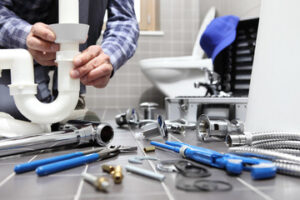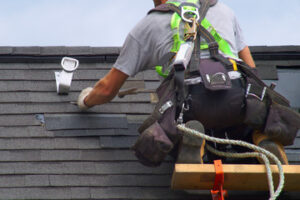Plumbing systems are complex networks of pipes that carry water and waste. They require regular maintenance to function properly. Plumbers use a variety of tools and techniques to perform their jobs. They also must follow strict building codes when installing or repairing plumbing fixtures. Contact Plumbing Express, Inc. for professional help.

Residential plumbing systems typically consist of two basic components: the water supply system and the drain system. The water supply system includes small pipes under pressure, which deliver water to fixtures at a high rate.
Plumbing is a highly rewarding career, especially for those who have the right qualifications. Plumbers are responsible for installing, repairing, and maintaining the pipes and fixtures that facilitate water supply, drainage, and waste disposal in residential, commercial, and industrial settings. This vital work ensures a safe and clean environment for occupants, while protecting the integrity of the building’s structure.
Qualifications for becoming a plumber vary by region, but most jurisdictions require at least a high school diploma or equivalent and a vocational training program. Those who wish to advance in the field may pursue additional certifications, such as in green plumbing practices or working with specific types of equipment. Plumbers must also be licensed by their local authorities in order to practice in the trade.
The licensing process can vary significantly by region, but it typically involves passing an exam and meeting minimum experience requirements. In addition, some states and cities have their own unique licensing requirements, such as continuing education or backflow testing certification. New York City, for example, requires that all master plumbers complete seven hours of continuing education every year in order to renew their licenses.
Once licensed, plumbers can work on both new construction and existing systems. In the former case, they will plan and lay out the pipe network according to the building’s design, ensuring that it meets local regulations regarding water pressure and drainage. Once the piping is in place, they can install sinks, toilets, tubs, and other fixtures. They will also connect the internal piping to external water and waste disposal systems, and test for leaks and other issues.
In existing buildings, plumbers will maintain and repair the current system. This can involve removing old fixtures and replacing them with new ones, fixing leaks, and conducting inspections to ensure that the building is up to code. They will also be responsible for backflow prevention, which is a key aspect of keeping contaminated water out of clean drinking water supplies. The CDC reports that backflow causes 7.15 million illnesses each year, so it’s important that plumbers are certified in this area of their work.
Water heaters
Water heaters are a key part of the modern home and help us get the job done, from washing clothes to cleaning dishes. But what goes on inside that simple box that makes your morning shower so satisfying? Here’s a look at the ingenious design on the inside that works together to make hot water possible.
Traditional water heaters use either fossil fuel (natural gas, liquefied petroleum gas or oil) or electricity to heat the water. The electricity can come directly from the fossil fuels, or it may come from other sources such as wind power, solar energy, district heating using waste heat from electricity generation or industrial processes, or from alternative sources such as geothermal heating.
The tank of a conventional water heater is usually made from heavy steel and insulated with polyurethane foam or another insulating material. It has a cold water inlet pipe, a hot water outlet pipe and a safety valve that is capped with metal or plastic overflow caps to prevent spills. The tank also has a dip tube that allows the hottest water to exit from the top of the tank. This is because hot water rises above cold water in a tank.
Depending on the type of tank used, water heaters can have a maximum capacity of 40 to 60 gallons (227 to 151 liters) at 50 to 100 pounds per square inch (PSI). Whether they are fuel- or electricity-based, most have an efficiency rating of about 95%.
Most homes have an existing electrical connection running to the location of the water heater. If not, an electrician can add a circuit. If the water heater is gas-based, a plumber must install the gas lines and vent the tank through a wall.
ENERGY STAR qualified water heaters have higher efficiency ratings than standard models. They can be electric or fuel-based and have a lower environmental impact, especially when using district heating using low carbon emissions sources such as the exhaust from electricity generation, and when used in conjunction with solar panels. Generally, these water heaters are more expensive to purchase and install than standard models, but can save money in the long run because of the lower operating costs.
Water softeners
Water softeners reduce the amount of hardness minerals in your household water supply. This removes the calcium and magnesium ions that create limescale, destroy plumbing fixtures, decrease appliance lifespans, limit the effectiveness of soaps and detergents, and make your skin and hair feel dry. In addition, many people find that water softeners help their clothes and dishes look brighter and feel softer, as well as smell fresher.
Unlike water filters that remove specific impurities from the water, such as chlorine and lead, water softeners do not affect the taste of your drinking water. The main component of a water softener is a mineral tank that holds a bed of resin beads. The water supply line feeds into the mineral tank, and the resin beads exchange calcium and magnesium ions for sodium ions. Once this process is complete, the water exits the mineral tank as softened water.
A control valve, power supply and brine tank are also required to operate the system. The control valve monitors the level of hardness minerals in the softened water and controls when the resin bed needs to be recharged with salt. The brine tank stores the salt solution used to regenerate the resin bed. Once the regeneration cycle is complete, the brine tank sucks the solution out of the mineral tank and into the drain, leaving behind the depleted resin beads.
The majority of water softeners use the ion exchange process to eliminate the unwanted hardness minerals from your household water. The ion exchange process involves passing water through columns of natural or synthetic aluminosilicates, which trade the hardness-producing ions for sodium ions. The exchangers are then flushed with water to rinse away the excess salt, returning them to service.
When selecting a water softener, be sure that it is rated for your household’s water usage and location. You don’t want to purchase a system that is too small, as it will not be effective, and an oversized system can cause problems with your water flow rate. For most households, a system with a 30,000-grain capacity is suitable, although it may be more economical to select a smaller, 18,000-grain model for single- or two-bathroom homes.
Backflow prevention devices
Backflow testing is a process that ensures your backflow prevention device is working properly. It’s a necessary step to protect your water supply and prevent dangerous contaminants from entering it. Water backflow can occur in many different ways, including a break in the main water line or when a fire hydrant is opened. Backflow prevention devices are designed to stop this from happening by keeping pressure changes from causing backflow.
There are several types of backflow prevention devices available, but the most popular is the reduced pressure zone (RP) assembly. This type of backflow prevention device is one of the safest and most dependable. It uses two check valves and a pressure differential release valve to separate the valves, which ensures that only clean water flows through the system. These valves are usually installed in areas where the risk of contaminated fluids is high, such as boilers and heat exchange equipment, industrial power washing and chemical cleaning equipment, and residential and commercial fire sprinkler systems.
The RP is also used when there’s not enough space to install an air gap backflow prevention device. It’s a popular choice for commercial buildings that are at high risk of contamination due to their plumbing configurations, such as restaurants and laundromats.
Backflow prevention devices are regulated by most governments. There are even some that require them to be tested annually. Failure to comply with these regulations can result in fines and even having your water shut off.
A backflow test is a quick and simple way to determine whether your backflow prevention device is functioning correctly. It is done by a backflow prevention specialist, and involves observing the flow of water in the reverse direction. The specialist will also inspect the piping for any potential problems and recommend any necessary repairs.
Backflow prevention devices are vital to the health and safety of everyone in your community. They can prevent dirty water from flowing into the municipal water supply, which could lead to serious diseases like dysentery and typhoid. They are also essential for preventing contamination from pesticides and fertilizers, as well as other harmful chemicals.





